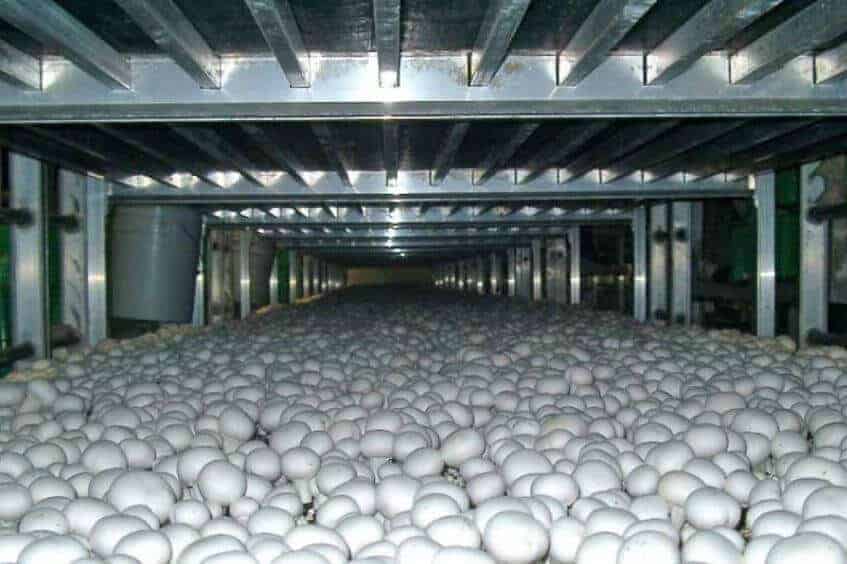New construction and renovations are giving a boost to Penn State research and extension programming related to mushrooms, one of Pennsylvania’s top agricultural crops.
The College of Agricultural Sciences at Penn State has a rich history of mushroom programs, dating to the early 1900s. The growth of these programs has paralleled, and contributed to, the success of the state’s $570 million mushroom industry, which produces nearly two-thirds of all Agaricus (white button) mushrooms grown in the United States.
Since 1960, the University’s Mushroom Research Center (MRC) has been the focal point of Penn State work in mushroom science and technology. From 1970 until recently, the nearby Mushroom Test Demonstration Facility — which operated in similar fashion to a small mushroom farm — complemented the center.
However, budget pressures and disrepair closed the demonstration facility in 2011, although researchers continued to use it to make compost needed as a substrate to grow mushrooms in the research center. When the test demonstration facility was demolished to make way for a water treatment plant in 2015, researchers were forced to acquire compost from outside suppliers.
Now, a newly completed compost building adjacent to the Mushroom Research Center is online, providing an improved composting system to support cropping needs, according to the center’s manager, John Pecchia, assistant professor of plant pathology. In addition, he noted, the Mushroom Research Center’s nine growing rooms are being renovated to ensure more consistent growing conditions and maximize the reliability of research results.
“Mushrooms tend to be finicky in terms of temperature and humidity,” said Pecchia, who also coordinates the college’s undergraduate mushroom science and technology minor. “The renovations will give us more precise control over the growing environment, which in turn gives us higher confidence in the data we collect during our studies.”
The Mushroom Research Center follows a three-week cropping schedule. Pecchia explained that the production process begins with phase-I composting, a six-day process during which straw, water, horse and poultry manure from Penn State farms, and other ingredients are mixed and aerated, reaching a temperature of 175 F.
During a six-day, phase-II composting stage, the compost is pasteurized and conditioned to remove ammonia. After cooling, the substrate is spawned and moved to a growing room for cropping.
The new compost building contains two phase-I bunkers and two phase-II tunnels, as well as a filling conveyor and net puller to empty the tunnels.
“Though the bunkers and tunnels are much smaller than those at a commercial operation, they are sized perfectly for the cropping schedule at the MRC,” Pecchia said. “After running several batches through the system, we can confirm that things are working well, and Penn State has a new and improved composting system to support the industry’s needs into the future.”
The Mushroom Research Center — one of the few facilities in the world dedicated to mushroom research — houses applied research aimed at improving commercial mushroom production. Studies include investigations of cultural practices, reuse of spent mushroom compost, odor reduction, reducing losses due to diseases, employing transgenic breeding techniques and developing methods for producing specialty mushrooms.
The results of Penn State mushroom research are shared with growers through Penn State Extension short courses, workshops, publications, online materials and other resources.



Nice information about Growing mushrooms. Growing this edible fungus is not an easy task to do as it takes many efforts to do. That is the reason behind that coveted brands are engaged in growing the healthier and fresh Mushroom logs maintaining its supreme quality. The best thing is that these brands keep paying extra attention and doggedly engaged in producing the best quality product to serve in the market. Shiitake is the “King of the Mushroom” and hold the quite lovely taste. It is loaded with the amino acids, multivitamin, and polysaccharide. The best thing is that a number of dishes available made up of using it. Shiitake stands for “Beech Mushroom” in Japanese. Shiitake Mushroom Logs is also quite fascinating to see. It holds incredible shape, shade, and size to lure the food lovers. Recently I have purchased Shiitake spawn from Agrinoon, who keeps working on the new technology to enhance the quality of the product.